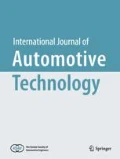Abstract
This study focuses on energy harvesting from vehicle suspension by employing a regenerative rotational shock absorber. Designing, manufacturing and testing of a prototype device is done step by step to provide a useful manual for researchers. The prototype damper was especially designed for low frequency applications. A rack-pinion mechanism was proposed to transform linear motion to rotational one. Unidirectional motion was realized by using a new combination of bearings and gear chain mechanism. This mechanical rectifier was coupled to light weight gear box with high reduction factor. Experimental studies were conducted in laboratory by utilizing a damper testing device. Excitation vibration motion on prototype was in constant amplitude (25 mm) and at variable low frequencies (0.16, 0.32 and 0.48 Hz). Additionally, different resistances were tested as an external load for electric generator (0.66 ∼ 10.4 Ω). Generated voltage and power in different case studies were presented. The maximum power was found to be 35 W and the maximum performance achieved was 34.36%. The range of calculated damping coefficient is in between 4800 Ns/m and 16000 Ns/m that is convenient for passenger and commercial vehicles.
Similar content being viewed by others
References
Abdelkareem, M., Xu, L., Guo, X., Ahmed Ali, M., Elagouz, A., Hassan, M., Essa, F. A. and Zou, J. (2018). Energy harvesting sensitivity analysis and assessment of the potential power and full car dynamics for different road modes. Mechanical Systems and Signal Processing, 110, 307–332.
Balkwill, J. (2018). Chapter 8 — Dynamic Modelling of Vehicle Suspension. Performance Vehicle Dynamics, Engineering and Applications. Butterworth-Heinemann. Oxford, UK, 241–317.
Gupta, A., Jendrzejczyk, J., Mulcahy, T. and Hull, J. (2006). Design of electromagnetic shock absorbers. Int. J. Mechanics and Materials in Design3, 3, 285–591.
Holman, J. (2012). Experimental Methods for Engineers. 5th edn. McGraw-Hill, New York, USA, 739.
Hsu, P. (1996). Power recovery property of electrical active suspension systems. Proc. 31st Intersociety Energy Conversion Engineering Conf., Washington, D.C., USA.
Karnopp, D. (1992). Power requirements for vehicle suspension systems. Vehicle System Dynamics: Int. J. Vehicle Mechanics and Mobility21, 1, 65–71.
Khoshnoud, F., Zhang, Y., Shimura, R., Shahba, A., Jin, G., Pissanidis, G., Chen, Y. K. and De Silva, C. W. (2015). Energy regeneration from suspension dynamic modes and self-powered actuation. IEEE/ASME Trans. Mechatronics20, 5, 2513–2524.
Li, P. and Zuo, L. (2013). Assessment of vehicle performances with energy-harvesting shock absorbers. SAE Int. J. Passenger Cars — Mechanical Systems6, 1, 18–27.
Li, Z., Zuo, L., Kuang, J. and Luhrs, G. (2013a). Energy-harvesting shock absorber with a mechanical motion rectifier. Smart Materials and Structures22, 2, 1–10.
Li, Z., Zuo, L., Luhrs, G., Lin, L. and Qin, Y.-X. (2013b). Electromagnetic energy-harvesting shock absorbers: Design, modeling, and road tests. IEEE Trans. Vehicular Technology62, 3, 1065–1074.
Nakano, K. and Suda, Y. (2004). Combined type self-powered active vibration control of truck cabins. Vehicle System Dynamics: Int. J. Vehicle Mechanics and Mobility41, 6, 449–473.
Sapinski, B. (2010). Vibration power generator for a linear MR damper. Smart Materials and Structures19, 10, 1–12.
Wei, C. and Jing, X. (2017). A comprehensive review on vibration energy harvesting: Modelling and realization. Renewable and Sustainable Energy Reviews, 74, 1–18.
Xie, L., Li, J., Li, X., Huang, L. and Cai, S. (2018). Damping-tunable energy-harvesting vehicle damper with multiple controlled generators: Design, modeling and experiments. Mechanical Systems and Signal Processing, 99, 859–872.
Yang, J. and Stabler, F. (2009). Automotive applications of thermoelectric materials. J. Electronic Materials38, 7, 1245–1251.
Zhang, X., Pan, H., Qi, L., Zhang, Z., Yuan, Y. and Liu, Y. (2017a). A renewable energy harvesting system using a mechanical vibration rectifier (MVR) for railroads. Applied Energy, 204, 1535–1543.
Zhang, Y., Chen, H., Guo, K., Zhang, X. and Li, S. (2017b). Electro-hydraulic damper for energy harvesting suspension: Modeling, prototyping and experimental validation. Applied Energy, 199, 1–12.
Zhang, Y., Huang, K., Yu, F., Gu, Y. and Li, D. (2007). Experimental verification of energy-regenerative feasibility for an automotive electrical suspension system. Proc. IEEE Int. Conf. Vehicular Electronics and Safety, Beijing, China.
Zhu, S., Shen, W.-A. and Xu, Y.-L. (2012). Linear electromagnetic devices for vibration damping and energy harvesting: Modeling and testing. Engineering Structures, 34, 198–212.
Zuo, L. and Zhang, P. (2013). Energy harvesting, ride comfort, and road handling of regenerative vehicle suspensions. J. Vibration and Acoustics135, 1, 48–65.
Zuo, L., Scully, B., Shestani, J. and Zhou, Y. (2010). Design and characterization of an electromagnetic energy harvester for vehicle suspensions. Smart Materials and Structures19, 4, 1–10.
Acknowledgements
The authors would like to thank the Scientific Research Projects Coordination Unit of Hacettepe University for their support in the funding of this research project (project code: FHD-2017-15058).
Author information
Authors and Affiliations
Corresponding author
Additional information
Publisher’s Note
Springer Nature remains neutral with regard to jurisdictional claims in published maps and institutional affiliations.
Rights and permissions
About this article
Cite this article
Amini, A., Ekici, Ö. & Yakut, K. Experimental Study of Regenerative Rotational Damper in Low Frequencies. Int.J Automot. Technol. 21, 83–90 (2020). https://doi.org/10.1007/s12239-020-0009-8
Received:
Revised:
Accepted:
Published:
Issue Date:
DOI: https://doi.org/10.1007/s12239-020-0009-8




